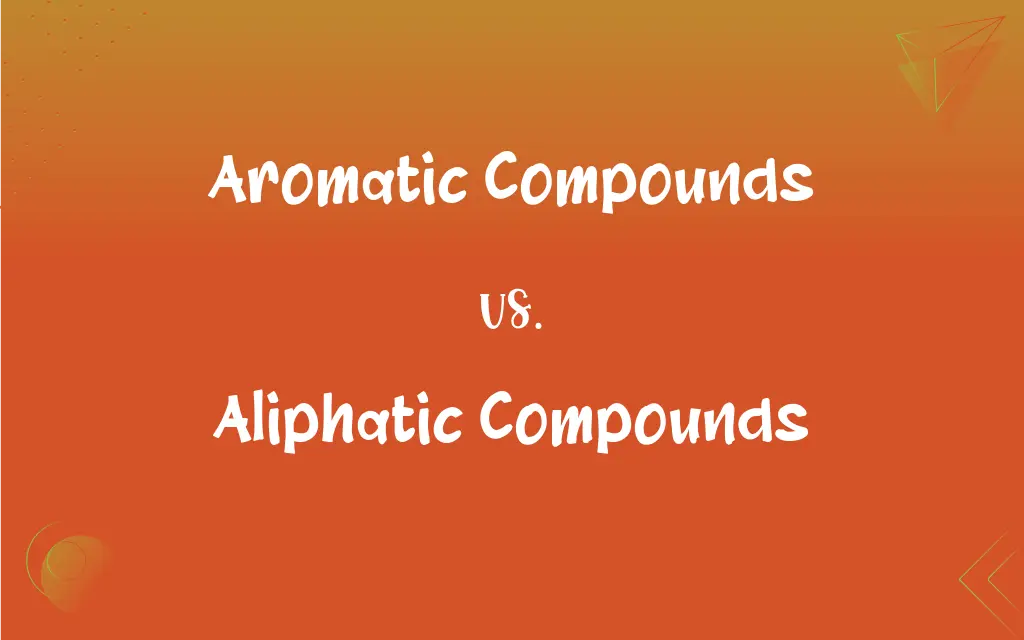Aromatic Compounds vs. Aliphatic Compounds: What's the Difference?
Edited by Aimie Carlson || By Harlon Moss || Updated on October 9, 2023
Aromatic compounds contain a ring of atoms with pi electrons delocalized across them, while aliphatic compounds consist of linear chains or non-aromatic rings without such electron delocalization.

Key Differences
Aromatic compounds are characterized by a cyclic, planar structure with a pi electron cloud that is delocalized across the ring atoms, offering stability. This property is largely derived from the specific electronic configuration, which adheres to Hückel's rule, implying that the compounds have (4n + 2) pi electrons. The most familiar example of an aromatic compound is benzene, which has a six-membered carbon ring and is renowned for its resonance stability.
Aliphatic compounds, on the other hand, might be saturated (alkanes) or unsaturated (alkenes or alkynes) and lack the stabilizing resonance seen in aromatics. These compounds can be straight-chained, branched, or cyclic (but not aromatic) in their structure. Methane, ethene, and propyne serve as representative members of alkanes, alkenes, and alkynes respectively, each depicting the diversity of structure and chemical behavior within aliphatic compounds.
Aromatic compounds often exhibit reduced reactivity in comparison to aliphatic compounds, primarily due to the stability provided by the delocalized electron cloud. The reactions they undergo, such as electrophilic aromatic substitution, tend to preserve the aromatic system because of its stability.
Contrastingly, aliphatic compounds can engage in a wider array of reactions, such as addition reactions (in the case of unsaturated aliphatics like alkenes and alkynes) or substitution and elimination reactions, without the need to preserve a delocalized electron system, since they don't possess one inherently.
Comparison Chart
Structural feature
Planar, cyclic, and pi electron cloud
Linear, branched, or non-aromatic ring
ADVERTISEMENT
Typical reactions
Electrophilic substitution
Addition, substitution, elimination
Stability
More stable (resonance stability)
Less stable
Examples
Benzene, toluene
Methane, ethene
Derived products
Dyes, drugs
Fuels, solvents
Aromatic Compounds and Aliphatic Compounds Definitions
Aromatic Compounds
Aromatic compounds can contain heteroatoms and still retain their aromaticity.
Furan, containing an oxygen atom, is aromatic due to the delocalization of pi electrons.
ADVERTISEMENT
Aliphatic Compounds
Aliphatic compounds lack the delocalized electron cloud characteristic of aromatics.
Propane, an aliphatic compound, is commonly used in portable stoves.
Aromatic Compounds
Aromatic compounds exhibit substantial resonance stabilization.
The benzene ring in phenol makes it more stable than its aliphatic counterpart.
Aliphatic Compounds
Aliphatic compounds do not adhere to Hückel's rule of aromaticity.
Butene, an aliphatic compound, is used in the polymer industry.
Aromatic Compounds
Aromatic compounds comply with Hückel's rule, having (4n + 2) pi electrons.
Pyridine is an aromatic compound even though it contains a nitrogen atom in the ring.
Aliphatic Compounds
Aliphatic compounds can be saturated (alkanes) or unsaturated (alkenes/alkynes).
Ethane is an aliphatic compound used in producing ethylene.
Aromatic Compounds
Aromatic compounds typically undergo electrophilic aromatic substitution reactions.
In the nitration of benzene, a nitro group substitutes one hydrogen atom on the ring.
Aliphatic Compounds
Aliphatic compounds often participate in addition reactions if unsaturated.
Ethylene, an aliphatic compound, reacts with bromine via an addition reaction.
Aromatic Compounds
Aromatic compounds have a ring structure with delocalized pi electrons.
Benzene, a simple aromatic compound, is utilized in the production of various chemicals.
Aliphatic Compounds
Aliphatic compounds can be linear, branched, or cyclic (non-aromatic).
Cyclohexane is a cyclic aliphatic compound utilized as a nonpolar solvent.
FAQs
Why is benzene considered an aromatic compound?
Benzene is aromatic due to its planar structure and delocalized pi electrons that follow Hückel's rule.
What's the significance of aromatic compounds in the pharmaceutical industry?
Aromatic compounds are vital in drug design due to their stability and ability to interact in biological systems.
Can aliphatic compounds be cyclic?
Yes, aliphatic compounds can be cyclic but lack the delocalized pi electrons of aromatics.
Are aliphatic compounds found in nature?
Yes, aliphatic compounds are widely distributed in nature, e.g., in fats and oils.
Do aliphatic compounds follow Hückel's rule?
No, aliphatic compounds do not follow Hückel's rule as it's specific to aromatics.
What is an example of an aliphatic compound?
Methane is a simple example of an aliphatic compound.
Are all aliphatic compounds gases at room temperature?
No, aliphatic compounds can be gases, liquids, or solids at room temperature, depending on molecular size.
Can an aromatic compound be synthesized from an aliphatic compound?
Yes, through specific synthetic pathways, aliphatic compounds can be transformed into aromatic compounds.
What types of aliphatic compounds exist?
Aliphatic compounds can be alkanes, alkenes, or alkynes, each varying in saturation and hybridization.
What defines an aromatic compound?
Aromatic compounds have a cyclic, planar structure with delocalized pi electrons.
Are all aromatic compounds derivatives of benzene?
No, aromatic compounds can also contain heteroatoms (e.g., furan) or have larger rings.
Can aliphatic compounds exhibit geometric isomerism?
Yes, specifically, aliphatic alkenes can exhibit geometric (cis-trans) isomerism.
How is aromaticity determined in a compound?
Aromaticity is determined by factors like planarity, cyclic structure, and compliance with Hückel's rule.
Can aromatic compounds be polymers?
Yes, aromatic compounds can be monomeric units in polymers, providing rigidity and stability.
How do aromatic compounds react chemically?
Aromatic compounds often undergo electrophilic aromatic substitution, preserving aromaticity.
How do aliphatic compounds react in comparison to aromatics?
Aliphatic compounds often engage in addition, substitution, or elimination reactions.
Is toluene an aromatic compound?
Yes, toluene, which is methylbenzene, is an aromatic compound.
What role do aromatic compounds play in perfumery?
Aromatic compounds are crucial in perfumery, providing specific scents and acting as scent stabilizers.
How are aliphatic compounds named in chemistry?
Aliphatic compounds are named based on the IUPAC nomenclature, considering chain length and substituents.
Are aliphatic compounds more or less reactive than aromatic compounds?
Generally, aliphatic compounds are more reactive due to the absence of aromatic stability.
About Author
Written by
Harlon MossHarlon is a seasoned quality moderator and accomplished content writer for Difference Wiki. An alumnus of the prestigious University of California, he earned his degree in Computer Science. Leveraging his academic background, Harlon brings a meticulous and informed perspective to his work, ensuring content accuracy and excellence.
Edited by
Aimie CarlsonAimie Carlson, holding a master's degree in English literature, is a fervent English language enthusiast. She lends her writing talents to Difference Wiki, a prominent website that specializes in comparisons, offering readers insightful analyses that both captivate and inform.
































































